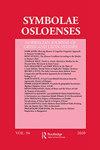Notes on the Text of Plautus, Menaechmi 497 and Truculentus 311–312
IF 0.1
3区 历史学
0 CLASSICS
引用次数: 0
Abstract
In this short note, I discuss the text of Menaechmi 497, where I argue for adopting A’s pol and propose the conjecture iam for eam, and Truculentus 311–312, where I argue for adopting P’s exportatur and propose bibitis for ebibitis. I argue that a proper understanding of the distinction between prefixed comesse (with a “perfectivizing” com-) and uncompounded esse is crucial to understanding these passages. I also discuss the rare verb exunguo and argue that both occurrences in Plautus are from an active verb which is being used reflexively (and not as a transitive deponent as often assumed).普劳图斯、梅纳希米497和特鲁库伦图311-312文本注释
在这个简短的笔记中,我讨论了Menaechmi 497的文本,在那里我主张采用A的pol并提出了团队的猜想iam,以及Truculentus 311-312,在那里我主张采用P的exportur并提出bibitis为ebibitis。我认为,正确理解前缀连词(带有“完美化”连词)和非复合连词之间的区别对于理解这些段落至关重要。我还讨论了罕见的动词exunguo,并认为在普劳图斯中两次出现都是来自一个主动动词,它是反身使用的(而不是通常认为的作为及物助词)。
本文章由计算机程序翻译,如有差异,请以英文原文为准。
求助全文
约1分钟内获得全文
求助全文

 求助内容:
求助内容: 应助结果提醒方式:
应助结果提醒方式:


